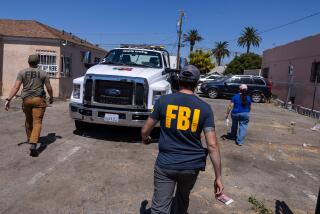FBI to Train Crime Scene Dive Team for L.A.
Almost a year ago, in the frigid, murky waters of the New Melones Reservoir near Sonora, a half-dozen divers and a remote-controlled vessel helped solve a crime more grisly than anyone had expected.
Four people from Los Angeles had been kidnapped and missing for days. A fifth had been abducted months earlier, his body -- then unidentified -- found floating in the water.
The only link between the crimes was theoretical until an elite team of FBI divers traveled from New York City to comb the deep waters. There, acting on a tip developed by Los Angeles FBI agents, the New York divers, working with a remote-controlled deep-water submersible, found the battered bodies of the four kidnap victims, all bound from behind like the earlier victim, 300 feet below the surface.
For two decades, the 12-member New York dive team was the only one in the FBI, whose ranks now approach 12,000 agents. From the Atlantic Ocean to California’s Gold Rush country, the divers were a key component of FBI crime scene investigations, responsible for locating and recovering evidence ranging from discarded handguns to plane crash debris.
Now, the New York team will be joined by a new group of divers from the Los Angeles FBI office. The Los Angeles team, in the planning stages for two years, received final FBI approval recently, in large part because of new counter-terrorism measures nationwide.
With tryouts in mid-February, the eight-member Los Angeles Underwater Search and Recovery Team will be selected from the Los Angeles office’s 660 current agents, who will undergo new training as divers but continue to work their regular assignments in between missions. The new dive team is expected to be operating by late spring.
“Their primary mission will be to recover evidence in federal cases, but they will be able to assist local and state law enforcement when and if they’re needed,” said Special Agent David Kice, evidence response team coordinator for the FBI in Los Angeles.
Other FBI dive teams will be formed in Miami and Washington, D.C.
With a surface-supplied air system rather than oxygen tanks and a mission to retrieve evidence from dark and muddy waters, the FBI’s divers often spend up to three hours at a time searching river bottoms or ocean floors for clues to a crime.
“They are literally creeping around on their hands,” Kice said.
“This assignment may seem like a great opportunity for someone to practice their hobby,” Kice said. “But the deployments are not going to be the kind that people would choose for their vacation.”
Formed in 1981, the New York dive team’s inaugural group included Navy SEALs, and its first assignment was a shocking crime: the execution-style slayings of four people, three of them CBS employees, in a parking lot off the Hudson River.
The FBI dive team played a key role in solving the case by recovering the murder weapon and other ammunition used by the killer. He had murdered the CBS employees when they tried to rescue the gunman’s original target in a brutal murder-for-hire.
In 1996, the team helped investigate another big case close to home: the horrific crash of TWA Flight 800 off Long Island.
And in 2000, the team helped investigate the attack on the U.S. destroyer Cole off Yemen in which 17 sailors died.
Over the years, the New York dive team has averaged at least a dozen assignments a year, said its coordinator, Special Agent Robert Chacon.
But unlike most dive teams, the work of the FBI squad is focused entirely on evidence recovery.
“Most of the state and local dive teams have a big rescue component because the public is much more sensitive to the idea of rescues than evidence recovery,” said Chacon. “The advantage we have in terms of training and time is that we don’t have to do rescues ... we make our living just searching.”
Although that mission can sometimes bring a spotlight to the work of the FBI dive team, most of its assignments occur outside the public’s view.
During the 1996 Summer Olympics, for example, FBI divers alert to the possibility of terrorism searched the submerged superstructure of massive viewing stands floating on Lake Lanier, north of Atlanta.
“The stands held 15,000 people and went 40 feet into the water,” said Chacon. “We would go down there every night and scan for any devices that might have been planted.”
In the aftermath of Sept. 11, Chacon said, he expects the FBI dive teams to be involved with other such counter-terrorism assignments. “I’m sure our role will be expanding,” he said. “You will see us involved more and more in things we have not traditionally done, like underwater surveys of bridges.”
Still, most often, the dive team’s assignments will focus on the sort of evidence recovery demonstrated during the grim search for bodies last March in the New Melones Reservoir.
“The investigators did a great job tying together five otherwise unrelated murders,” said Los Angeles Agent Kice, a former forensic anthropology consultant for the L.A. County coroner.
Though the California search was typical in terms of mission, it was atypical in terms of the environment, Chacon said.
“Those bodies were about 300 feet deep,” said Chacon, recalling how divers spent hours in poor visibility combing the lake.
Chacon, who came to the dive team after more than a dozen years investigating organized crime and Jamaican drug gangs, said the Los Angeles team, like New York’s, will draw upon agents with an array of experience and other assignments.
Kice added that members of the new team must have at least two years with the bureau and an open-water diving certification.
Significantly, the divers must also understand that their new assignment cannot take the place of their current job, be it bank robbery investigations or foreign counterintelligence.
Said Kice: “Unless they are serving a search warrant or in trial or engaged in some other activity that just cannot be postponed, they will be expected to go ... when they get the call to dive.”
More to Read
Sign up for Essential California
The most important California stories and recommendations in your inbox every morning.
You may occasionally receive promotional content from the Los Angeles Times.










